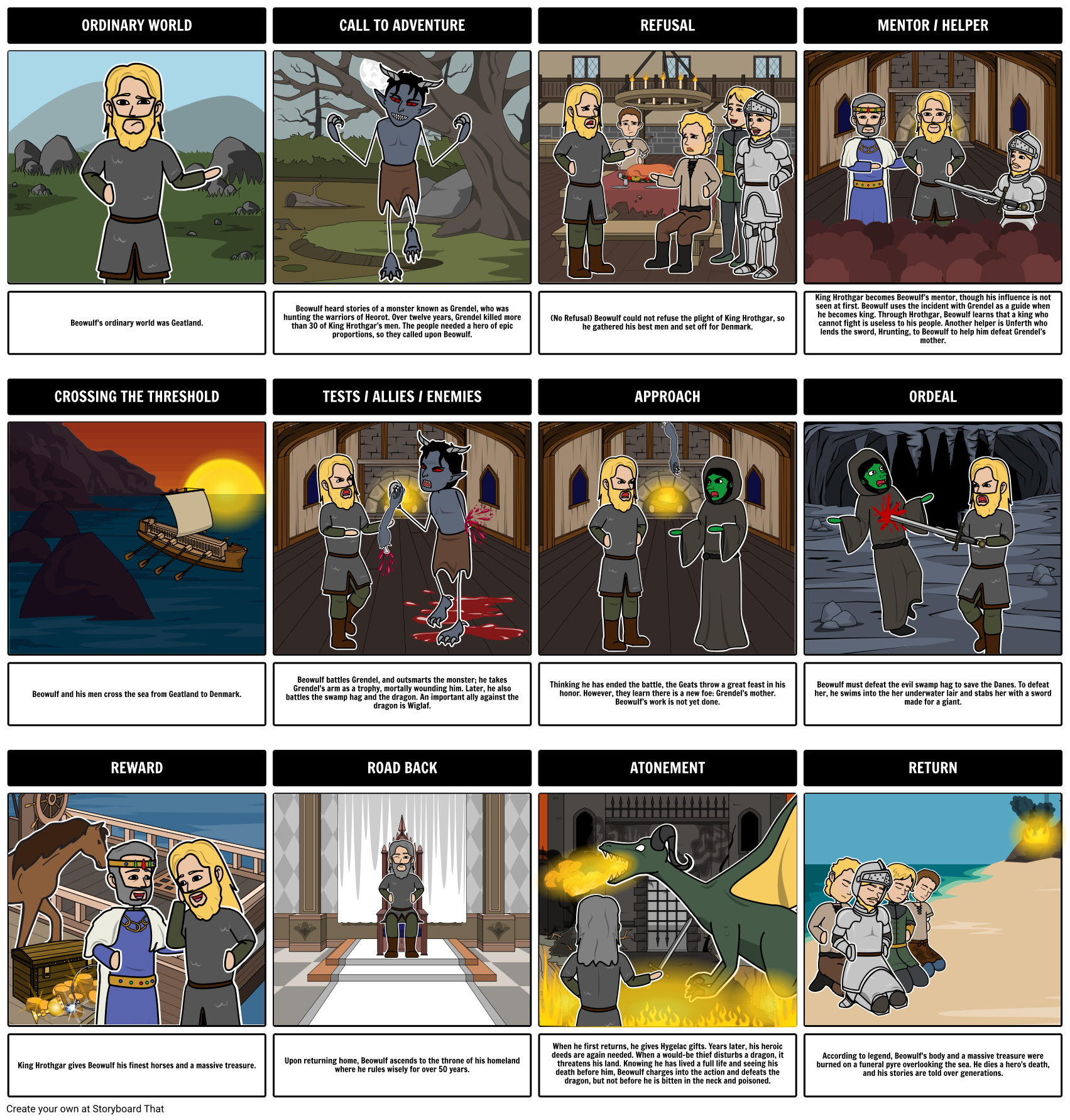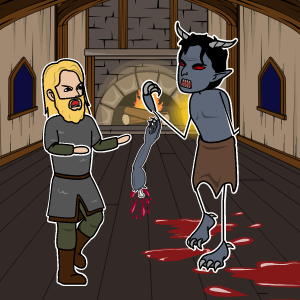Lesson Plan Overview
Related to both plot diagram and types of literary conflict, the Hero’s Journey is a recurring pattern of stages many heroes undergo over the course of their stories. Joseph Campbell, an American mythologist, writer, and lecturer, articulated this cycle after researching and reviewing numerous myths and stories from a variety of time periods and regions of the world. He found that they all shared fundamental principles. This spawned the Hero’s Journey, also known as the Monomyth. The most basic version has 12 steps, while more detailed versions can have up to 17.
After introducing students to the Hero's Journey, they'll be able to spot how Beowulf fits this structure. Students can choose to identify each step as they read, or wait until they've finished the story to apply the monomyth structure to the story. Using a storyboard, they can easily depict the structure, complete with examples!
The template and activity can be scaffolded or tailored based on your student's needs. The template provided has each cell labeled with the name of the step, but you can choose to add additional information, like a list of scenes, a completed cell, or specific examples.
Template and Class Instructions
(These instructions are completely customizable. After clicking "Copy Activity", update the instructions on the Edit Tab of the assignment.)
Student Instructions
Use the story of Beowulf and map it to the narrative structure of the Hero's Journey.
- Click "Start Assignment".
- Depict and describe how the chosen character's story fits (or does not fit) into each of the stages of the Hero's Journey.
- Finalize images, edit, and proofread your work.
Lesson Plan Reference
Student Rubric
(You can also create your own on Quick Rubric.)
| Exemplary 20 Points | Proficient 17 Points | Commendable 13 Points | Try Again 10 Points | |
|---|---|---|---|---|
| Content | | | | |
| Organization | | | | |
| Visual Elements | All pictures demonstrate effort, are attention-grabbing, and clearly communicate visually the corresponding element of the hero's journey. | Many pictures show effort and clearly communicate how an element of the hero's journey is present in the story. | Some pictures appear rushed, or are uninteresting. Connections to elements of the hero's journey are non-obvious, or unclear. | Few pictures appear. The storyboard appears rushed, or unfinished. The connections and elements are very unclear. |
| Conventions | There are only minor errors in grammar, punctuation, spelling, or usage, if any. | There are few errors in grammar, punctuation, spelling, or usage. | There are many errors in grammar, punctuation, spelling, or usage. | There are abundant errors in grammar, punctuation, spelling, or usage that detract from the work. |
| Creativity/Effort | This Storyboard could be used as an exemplary model, and is one of the most outstanding projects produced. | Creativity is evident, and the finished product is admirable. | Creativity and effort are lacking. Extra help was needed. | Creativity and effort are lacking. Extra help was needed. |
Lesson Plan Overview
Related to both plot diagram and types of literary conflict, the Hero’s Journey is a recurring pattern of stages many heroes undergo over the course of their stories. Joseph Campbell, an American mythologist, writer, and lecturer, articulated this cycle after researching and reviewing numerous myths and stories from a variety of time periods and regions of the world. He found that they all shared fundamental principles. This spawned the Hero’s Journey, also known as the Monomyth. The most basic version has 12 steps, while more detailed versions can have up to 17.
After introducing students to the Hero's Journey, they'll be able to spot how Beowulf fits this structure. Students can choose to identify each step as they read, or wait until they've finished the story to apply the monomyth structure to the story. Using a storyboard, they can easily depict the structure, complete with examples!
The template and activity can be scaffolded or tailored based on your student's needs. The template provided has each cell labeled with the name of the step, but you can choose to add additional information, like a list of scenes, a completed cell, or specific examples.
Template and Class Instructions
(These instructions are completely customizable. After clicking "Copy Activity", update the instructions on the Edit Tab of the assignment.)
Student Instructions
Use the story of Beowulf and map it to the narrative structure of the Hero's Journey.
- Click "Start Assignment".
- Depict and describe how the chosen character's story fits (or does not fit) into each of the stages of the Hero's Journey.
- Finalize images, edit, and proofread your work.
Lesson Plan Reference
Student Rubric
(You can also create your own on Quick Rubric.)
| Exemplary 20 Points | Proficient 17 Points | Commendable 13 Points | Try Again 10 Points | |
|---|---|---|---|---|
| Content | | | | |
| Organization | | | | |
| Visual Elements | All pictures demonstrate effort, are attention-grabbing, and clearly communicate visually the corresponding element of the hero's journey. | Many pictures show effort and clearly communicate how an element of the hero's journey is present in the story. | Some pictures appear rushed, or are uninteresting. Connections to elements of the hero's journey are non-obvious, or unclear. | Few pictures appear. The storyboard appears rushed, or unfinished. The connections and elements are very unclear. |
| Conventions | There are only minor errors in grammar, punctuation, spelling, or usage, if any. | There are few errors in grammar, punctuation, spelling, or usage. | There are many errors in grammar, punctuation, spelling, or usage. | There are abundant errors in grammar, punctuation, spelling, or usage that detract from the work. |
| Creativity/Effort | This Storyboard could be used as an exemplary model, and is one of the most outstanding projects produced. | Creativity is evident, and the finished product is admirable. | Creativity and effort are lacking. Extra help was needed. | Creativity and effort are lacking. Extra help was needed. |
How To Apply the Monomyth Structure to Poems
Introduce Monomyths
Teachers can first introduce the concept of Monomyths or The Hero’s Journey to the students. They can also ask the students to carry out research in their own time and discuss their findings with the class.
Identify Different Stages
After reading and discussing a specific piece of poetry, the teachers can introduce different stages of Monomyths to students and ask them to identify these stages within the poem.
Use Expressive Language
Ask the students to use expressive and vivid language to describe the Hero’s Journey and adventure. By using such language, they can convey both the physical and emotional aspects of the journey and make use of perspectives.
Strengthen Themes
Make sure the Hero's Journey's stages correspond to the topics you intend to express in the poetry.
Use Visuals
Encourage the students to use graphics and visuals for each stage for a better understanding. This can be an interesting activity for the students as they will be able to experience the journey with the hero in a different way.
Frequently Asked Questions About Beowulf Hero’s Journey
Who is "Beowulf’s" mentor character?
The mentor figure in "Beowulf" can be observed in figures like Hrothgar, the knowledgeable and experienced ruler who advises Beowulf during his fights.
What is "Beowulf’s" threshold crossing?
When Beowulf departs from his native Geatland and enters the Danes' territory in answer to Hrothgar's cries for assistance, this threshold crossing in "Beowulf" takes place.
What challenges and tests does Beowulf encounter?
Battles with Grendel, Grendel's mother, and the dragon are among Beowulf's tribulations. These difficulties put his fortitude, tenacity, and resolve to the test.
What is Beowulf's reward in the poem "Beowulf"?
Grendel's arm, Grendel's mother's head, and the dragon's riches are the prizes that Beowulf obtains after winning each of his battles. These prizes stand for his successes and accomplishments.
What in "Beowulf" is the "Atonement with the Father" stage?
This scene in "Beowulf" can be seen as Beowulf's battle with the dragon, which stands in for his ultimate test and a return to his warrior origins.
What happens after the "Return with the Elixir" in "Beowulf"?
Beowulf defeats the dragon but eventually passes away from his wounds. In the end, his legacy is honored after his return to the Geatland with the dragon's riches and the knowledge of his valiant deeds.
More Storyboard That Activities
Beowulf
This Activity is Part of Many Teacher Guides
Testimonials

“By using the product, they were so excited and they learned so much...”–K-5 Librarian and Instructinal Technology Teacher

“I'm doing a Napoleon timeline and I'm having [students] determine whether or not Napoleon was a good guy or a bad guy or somewhere in between.”–History and Special Ed Teacher

“Students get to be creative with Storyboard That and there's so many visuals for them to pick from... It makes it really accessible for all students in the class.”–Third Grade Teacher
© 2025 - Clever Prototypes, LLC - All rights reserved.
StoryboardThat is a trademark of Clever Prototypes, LLC, and Registered in U.S. Patent and Trademark Office









